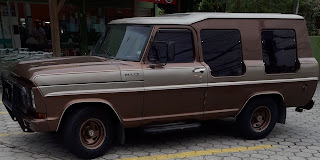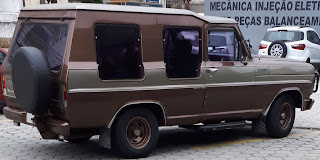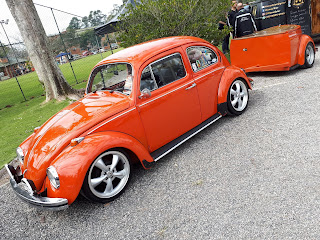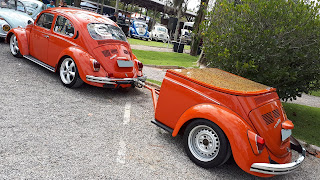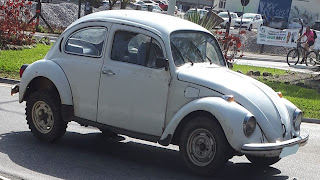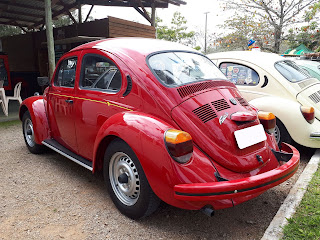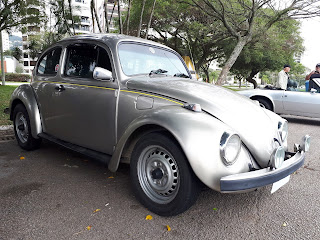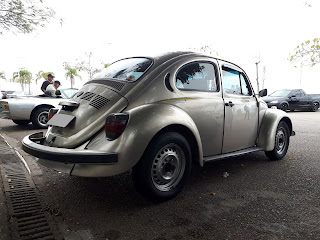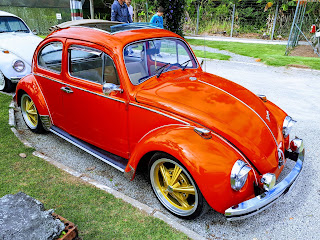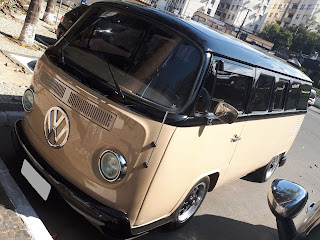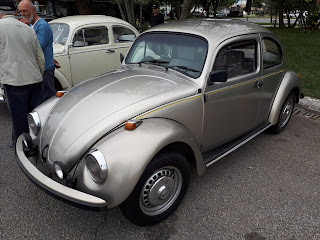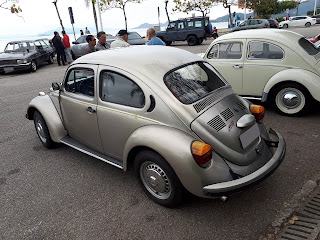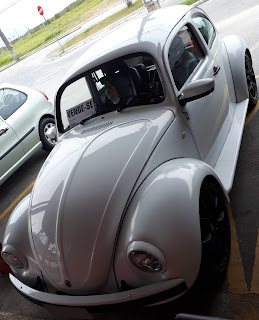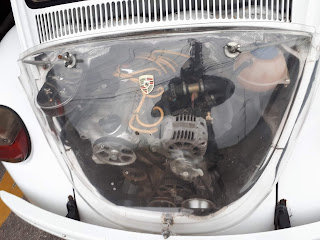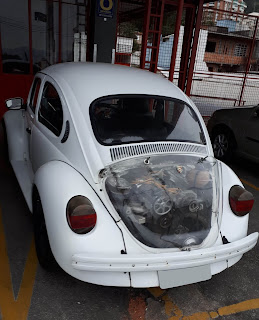It may seem odd at a first glance, but the full-size Ford trucks range in Brazil didn't follow the same evolution path of its American/Canadian/Mexican and Argentinian counterparts, with local variants of the 5th generation being introduced only in '72 when it was already being phased out anywhere else, with a subtle facelift which led to the introduction of a plastic grille and 4 square headlamps, and soldiering on until '92 when a switch to the 8th generation was on course. Unique to the local market was the F-1000 which was basically an equivalent to the F-250 with the short-bed bodystyle of the F-100 and a regionally-sourced 3.9L MWM D-229-4 Diesel engine later also available with turbo, or the Thriftpower Six imported from Argentina in a dedicated-ethanol version specific for the Brazilian F-1000 or in a regular gasoline-powered version only in '90.
It used to be quite common to see many aftermarket conversions for full-size trucks in Brazil, which were also somewhat of an attempt to fill the gaps left by the restrictions against car imports between '76 and '90. Among those, there were some bodyworks halfway between an SUV and a full-size van, often leading to such vehicles being mistaken for a Mexican Ford B-100 or similar conversions which also used to be performed in Argentina where they're often referred to as "F-100 carrozada" or "F-100 rural". What might surprise Americans and Canadians the most is the resemblance to the panel vans based on older generations of the F-Series, but the absence of the Econoline vans in other markets by then has led to such conversions having their popularity, even though in Brazil they were more often seen as a recreational vehicle than as a workhorse.
Tuesday, September 24, 2019
Tuesday, September 17, 2019
Beetle with a matching trailer
I'm not really into matching trailers, but this one I spotted at a car show caught my attention. Not sure if it resorted to a chopped Beetle floorpan or a dedicated frame.
Sunday, September 08, 2019
Why would I still consider buying a Beetle?
One of those cars that have created new standards at the time of its introduction, even though some of its features fell out of favor among the general public, the Beetle still retains a strong cult-following in countries such as Brazil where it's often praised for addressing effectively the needs of its buyers. Unlike newer generations of subcompacts which have stripped-down versions advertised as "people's car", and other projects specific for the so-called emerging markets while still catering mostly to the urban customers, its mild off-road ability renders the Beetle suitable to rural and suburban users who either couldn't afford some 4WD utility vehicle or didn't want to deal with the technical complexity associated to that feature. Knobby tyres on the rear end, and eventually some selective rear braking similar to what is used in some farm tractors (and that could be easily implemented using the parking brake cables), are enough for a Beetle to cope with most of the rough terrain conditions...
Sure it's undeniable the Beetle may seem too outdated when compared to other "people's car" projects which were eventually meant to serve as an indirect replacement for it, but the shift in the customers' mindset simply reflects other changes in a broader social and economical context. The relaunch of the Beetle in '93 in Brazil, only to be definitely phased out locally in '96, was clearly more influenced by a wish of then-president Itamar Franco who believed it would boost sales of "people's cars" instead of a technically-biased decision. Its body-on-platform layout rendered it uncompetitive for a large-scale production while compared to newer unibody cars, including the 2nd-generation Gol released in '94 and initially resorting to the Ford-sourced 1.0L CHT engine renamed AE by the Brazilian branch of Volkswagen until '96. Since the "people's car" program rules had to be amended just in order to allow the Beetle with its air-cooled 1.6L engine to take benefit of a lower tax bracket at the time meant for engines up to 1.0L regardless of the cooling system, switching back soon after the Beetle bit the dust again, the "Fusca Itamar" ended up more as a marketing stunt than as a serious attempt to address the needs of customers.
It could seem out of question to even lurk about the possibility of getting a Beetle when something more modern was available for roughly the same price, but it's not that easy to single-out which could be the best vehicle within one or more size classes that could often overlap each other. Considering the specificities of the Brazilian market in the early '90s, still reflecting the reserve for locally-made cars held between '76 and '90, the closest contender to the Beetle regarding strictly its off-road ability was the Suzuki Samurai, predictably disfavored among customers with a more traditional profile who would not be willing to deal with the smaller availability of official technical assistance. And even though the Samurai had been more often imported to Brazil with a 1.3L engine which for being water-cooled didn't benefit from the same amendment on the "people's car" program that favored the Beetle, there were a few imported with a 970cc engine which enabled it to qualify for the lower taxes. Considering that both models were designed according to programs similar to the Brazilian "people's car", even though the Beetle catered to a broader array of customers while the Samurai being a 4WD became somewhat more aspirational as a specialty vehicle, it doesn't make so much sense to compare sales figures.
The lack of any serious evolution between the original production run of the Beetle in Brazil and the Itamar, which didn't even get the upgraded rear suspension with semi-trailing arms and coil springs, is obviously a matter of concern. Stiffer sway bars may already provide some degree of compensation to the side-effects of the stock rear swing-axle, even though it's not impossible to install the improved rear suspension which in Brazil was found on the Transporter/Kombi since '76, which may be enough to keep its handling more up-to-date within normal operating conditions, and even the retrofitting of an ABS system if desired is not out of question despite the projects' age. It's also worth noticing the possibility to implement higher-capacity brakes, which could handle some more spirited driving and eventually address the higher efforts which would be imposed either by some engine tuning or by its swap for a modern one. Comfort features now highly sought after on new vehicles but not so much when the Beetle and the Kombi were mainstream, such as air conditioning and power steering, can be fitted too, with or without other improvements.
Be it for the simple mechanics and the utilitarian approach, or some more subjective reasons such as the iconic appearance, a Beetle may still be considered desirable by customers with distinct profiles. Easy to fix with simple tools, capable to withstand to some degree of maintenance neglect, and lower-grade fuel and other supplies such as engine oils, even the controversial relaunch could be considered a sign that a vehicle with at least some of the Beetle's features was effectively needed in Brazil back in the day. Not so fancy as neither other classic cars or most of its modern indirect replacements, the Beetle might be far from being a strictly-reasonable buy but is not unjustifiable at all...
Sure it's undeniable the Beetle may seem too outdated when compared to other "people's car" projects which were eventually meant to serve as an indirect replacement for it, but the shift in the customers' mindset simply reflects other changes in a broader social and economical context. The relaunch of the Beetle in '93 in Brazil, only to be definitely phased out locally in '96, was clearly more influenced by a wish of then-president Itamar Franco who believed it would boost sales of "people's cars" instead of a technically-biased decision. Its body-on-platform layout rendered it uncompetitive for a large-scale production while compared to newer unibody cars, including the 2nd-generation Gol released in '94 and initially resorting to the Ford-sourced 1.0L CHT engine renamed AE by the Brazilian branch of Volkswagen until '96. Since the "people's car" program rules had to be amended just in order to allow the Beetle with its air-cooled 1.6L engine to take benefit of a lower tax bracket at the time meant for engines up to 1.0L regardless of the cooling system, switching back soon after the Beetle bit the dust again, the "Fusca Itamar" ended up more as a marketing stunt than as a serious attempt to address the needs of customers.
It could seem out of question to even lurk about the possibility of getting a Beetle when something more modern was available for roughly the same price, but it's not that easy to single-out which could be the best vehicle within one or more size classes that could often overlap each other. Considering the specificities of the Brazilian market in the early '90s, still reflecting the reserve for locally-made cars held between '76 and '90, the closest contender to the Beetle regarding strictly its off-road ability was the Suzuki Samurai, predictably disfavored among customers with a more traditional profile who would not be willing to deal with the smaller availability of official technical assistance. And even though the Samurai had been more often imported to Brazil with a 1.3L engine which for being water-cooled didn't benefit from the same amendment on the "people's car" program that favored the Beetle, there were a few imported with a 970cc engine which enabled it to qualify for the lower taxes. Considering that both models were designed according to programs similar to the Brazilian "people's car", even though the Beetle catered to a broader array of customers while the Samurai being a 4WD became somewhat more aspirational as a specialty vehicle, it doesn't make so much sense to compare sales figures.
The lack of any serious evolution between the original production run of the Beetle in Brazil and the Itamar, which didn't even get the upgraded rear suspension with semi-trailing arms and coil springs, is obviously a matter of concern. Stiffer sway bars may already provide some degree of compensation to the side-effects of the stock rear swing-axle, even though it's not impossible to install the improved rear suspension which in Brazil was found on the Transporter/Kombi since '76, which may be enough to keep its handling more up-to-date within normal operating conditions, and even the retrofitting of an ABS system if desired is not out of question despite the projects' age. It's also worth noticing the possibility to implement higher-capacity brakes, which could handle some more spirited driving and eventually address the higher efforts which would be imposed either by some engine tuning or by its swap for a modern one. Comfort features now highly sought after on new vehicles but not so much when the Beetle and the Kombi were mainstream, such as air conditioning and power steering, can be fitted too, with or without other improvements.
Friday, September 06, 2019
EA827-swapped Beetle with a clear plexiglass engine lid
Seeing a Beetle which had its stock air-cooled boxer engine replaced with something more modern, usually a Volkswagen EA827, is not so unusual at all in Brazil, even though it's a quite controversial mod among local Beetle enthusiasts.
This one specifically, a '94-'95 "Itamar series", had a clear plexiglass engine lid that makes it quite obvious the stock boxer is gone while the EA827 made its way inside...
This one specifically, a '94-'95 "Itamar series", had a clear plexiglass engine lid that makes it quite obvious the stock boxer is gone while the EA827 made its way inside...
Subscribe to:
Comments (Atom)
